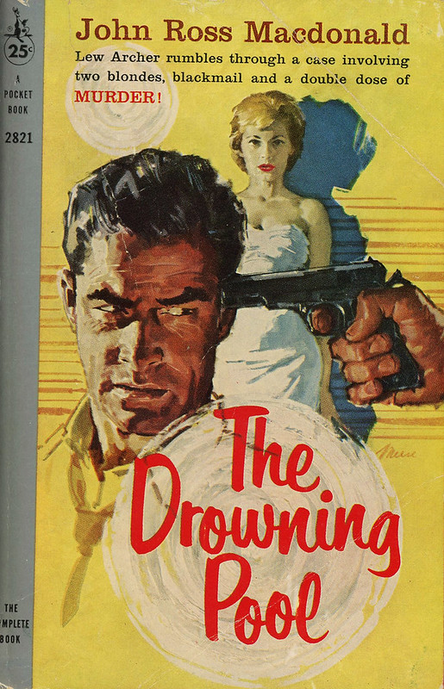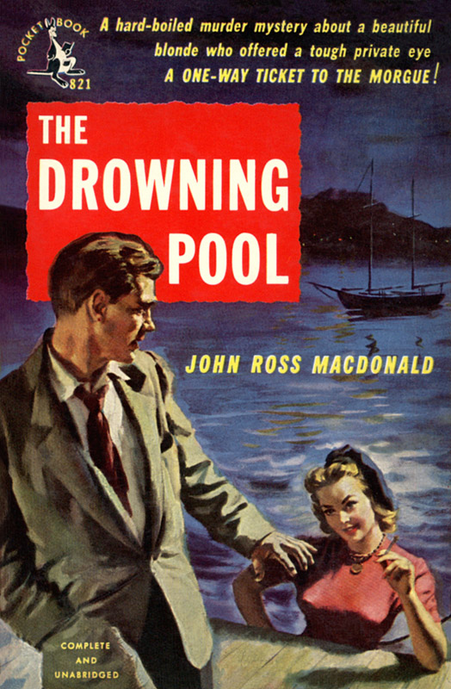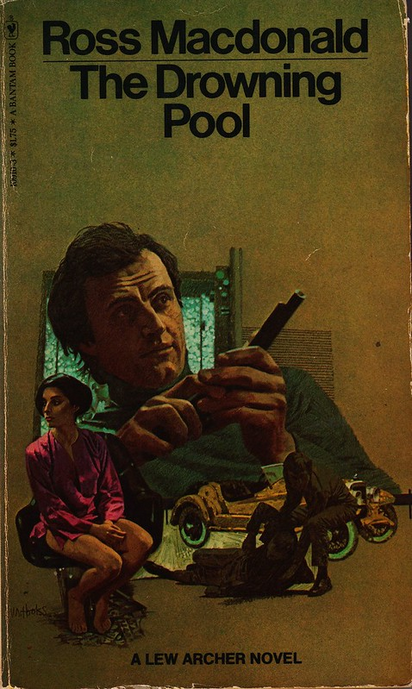


Lew Archer, Ross MacDonald’s private eye creation has appeared in 18 novels over a number of decades from 1949 to 1976. MacDonald’s real name is Kenneth Millar and he was married to crime fiction writer, Margaret Miller, making a power couple in fiction writing. The Drowning Pool (1950) was book two in the series, which was made into a 1975 movie starring Paul Newman.
We don’t learn a great deal about who Archer is except that he is world-weary, that he is divorced, and that ultimately he investigates because he believes in truth and wants the truth to come out even if it causes a ruckus. Although his office in his Los Angeles, the case is set for the most part (although there are scenes in Los Angeles and Las Vegas) in Quinto and Nopal Valley, two made-up places that do not necessarily correspond to much on the map except we learn that they are north of Santa Monica, that Quinto has a port, and that Nopal Valley has oil, much perhaps on several large estates.
The story opens with Archer in his office and a nervous client approaching him. We get an understanding of who this client is well before we get her name (Maude Slocum): “If you didn’t look at her face she was less than thirty, quick-bodied and slim as a girl. Her clothing drew attention to the fact: a tailored sharkskin suit and high heels that tensed her nylon-shadowed calves.” We learn that she stands in the doorway nibbling her teeth and clutching her black suede purse. “Her stance was awkward with urgency.”
The case involves – at least initially- a letter threatening to expose Maude’s extramarital affair to her husband, the one with an unmanned voice, like a hysterical boy who Maude refers to as a “whining jellyfish.” Her husband’s mother controls “the money” in the family and would just as well be rid of Maude. It is imperative that it be kept from everyone, including Maude’s teenage daughter, Cathy, who is caught fooling around with Pat Reavis, the sometime shofar. Reavis, we are told, “had quantities of raw charm. But underneath it there was something lacking. I could talk to him all night and never find his core, because he never found it.”
Ultimately, Lew Archer novels are not so much about the spats among wealthy family members or the crooked developers who nose their way in so much as they are about characters and who they are at their core. Archer, at his core, isn’t just a gun for hire. He ultimately wants to do the right thing though he is tempted at times to waltz down to Acapulco with the latest ash-blonde temptress in need of a knight in shining armor. This blonde was Mrs. Mavis Kilbourne and “[h]er atmosphere was like pure oxygen; if you breathed it deep it could make you dizzy and gay, or poison you.”
Were he to succumb to such temptation though would he still be the Archer we know or will he have lost something along the way. Or is he just as he wonders at one point simply a shadow-figure in the mirror “without a life of his own who peered with one large eye and one small eye through dirty glasses at the dirty lives of people in a very dirty world.”
Even back in 1950, MacDonald, through his cipher, Archer, muses on how built up Southern California had become with jerrybuilt beaches from San Diego to the Golden Gate and superhighways bulldozed through the mountains, cutting down a thousand years of redwood growth. In this vein, he sounds like his namesake John D. MacDonald with Travis McGee talking about how Florida was overbuilt. “There is nothing wrong with Southern California,” we are told, “that a rise in the ocean level wouldn’t cure.” When he says this, though, you wonder if he is talking about the excess development or about the empty petty people and their twisted rotten lives.
I remember reading a number of Archer books back in the 1970s. Like a lot of mystery novels I had no real sense they were set so far in the past — they seemed pretty timeless (this may reflect which ones I read).
Trivia note: I’ve read the Newman film was named Harper (and Archer renamed accordingly) because Newman had had good luck with Hud and The Hustler so he figured “H” was a lucky letter.
LikeLike